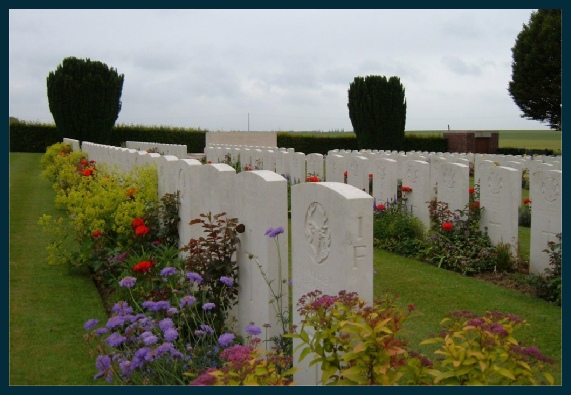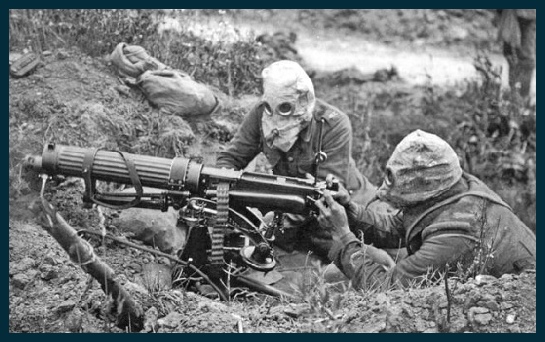Copyright © All rights reserved.



Charles Rickman
At first glance, there seems to be absolutely no mention of a suitable Charles Rickman either in Censuses, birth records or military records.
However further investigation reveals a Charles Richman who might be relevant: Lance Serjeant CHARLES RICHMAN 67678, 208th Bn., Machine Gun Corps (Infantry) who died aged 25 on 27 November 1917. Son of Waters and Lily Richman, of Ivy Cottage, Menethorpe, Malton, Yorks. Native of Scrayingham, Stamford Bridge, York.
Remembered with honour ANNEUX BRITISH CEMETERY
Charles Richman’s birth was registered first quarter of 1893 at Malton This identification would seem to be confirmed by the Memorial Hall tablet where Charles Rickman is recorded as serving with the Machine Gun Corps.
Fortunately facsimiles of much of this individual’s documentation are available online and among vast amounts ambiguous handwriting including Charles’ signature, one form showing his willingness to serve overseas gives his name unambiguously as Rickman with the same signature as on all the documents which are readable as either! So despite the fact that all the transcribed evidence, including his tombstone, show him as Richman, he is clearly the same man (probably actually called Richman)!
In 1901 Charles was living in Village Street, Howsham with his parents and siblings.
1901 Census – resident at Village Street, Howsham
RICHMAN, Waters, Head, Married, M, 39, Coachman, Westow Yorkshire,
RICHMAN, Lilly, Wife, Married, F, 33, , Bradford Yorkshire,
RICHMAN, Walter, Son, Single, M, 11, , Howsham Yorkshire,
RICHMAN, Ethel, Daughter, Single, F, 9, , Howsham Yorkshire,
RICHMAN, Charles, Son, Single, M, 8, , Howsham Yorkshire,
RICHMAN, Mabel, Daughter, Single, F, 4, , Howsham Yorkshire,
By 1911 his parents and youngest sister had moved to Scrayingham but he had left home and appears working as a footman for an ironmaster at Biddulph in Staffordshire.
1911 Census – resident at Biddulph Grange, Biddulph, Staffordshire
HEATH, Robert, Head, Widower, M, 60, Ironmaster, Stafford Kidsgrove,
HEATH, Frederick Stanley, Son, Single, M, 30, Ironmaster, Stafford Norton,
WILLIAMS, Robert, Servant, Single, M, 63, Butler, Flint Northorp,
HOUSE, Ernest, Servant, Single, M, 25, Footman, Bucks Dropmore,
RICKMAN, Charles, Servant, Single, M, 19, Footman, Yorkshire Howsham,
APPLETON, Mary, Servant, Single, F, 52, Cook, Yorkshire Morton,
BRUNDRIT, Isabella, Servant, Single, F, 40, Ladies Maid, Cheshire Chortlon cum Hardy,
TAYLOR, Annie, Servant, Single, F, 21, Kitchen Maid, Derby Kilborn,
BORNM, Annie, Servant, Single, F, 20, Kitchen Maid, Stafford Biddulph,
BURDIS, Kate Ada, Servant, Single, F, 41, Housemaid, Middlesex Tottenham,
GREEN, Rose, Servant, Single, F, 21, Housemaid, Shropshire Ludlow,
By the outbreak of war on 4th August 1914 Charles was working as an insurance agent for Britannia Assurance and living at 13 Low St Agnes Gate Ripon. That very weekend on the 8th August, he signed up in York for the 5th Battalion (Territorials) of the West Yorkshire Regiment. After a while during which the battalion was stationed at York, Selby, Strenshall an d Gainsborough they were finally sent as part the British Expeditionary Force to Boulogne on 15th April 1915, and Charles served in the field with the 5th battalion until 27th January 1916 when he was attached to the 146th Brigade Machine Gun Company. On 7th September he sustained a gunshot wound to the leg and was admitted to hospital. He was invalided home to UK on the Hospital Ship Brighton on 9th September to the Military Hospital at Leicester and then was posted to Home Duty at Peasey Hills, Old Malton until 8th November. This seems to constitute the sum total of his link with Old Malton.
d Gainsborough they were finally sent as part the British Expeditionary Force to Boulogne on 15th April 1915, and Charles served in the field with the 5th battalion until 27th January 1916 when he was attached to the 146th Brigade Machine Gun Company. On 7th September he sustained a gunshot wound to the leg and was admitted to hospital. He was invalided home to UK on the Hospital Ship Brighton on 9th September to the Military Hospital at Leicester and then was posted to Home Duty at Peasey Hills, Old Malton until 8th November. This seems to constitute the sum total of his link with Old Malton.
At this point he was transferred to the Machine Gun Corps and was sent back to France on 25th February 1917, joining 208th Company as a Corporal the following day. He would have found himself well and truly in the midst of the operations on the Ancre that followed the battle of the previous year.
In March 1917, the German armies on the Somme carried out a strategic withdrawal known as Operation Alberich. They destroyed everything on the ground that they left: flattening villages, poisoning wells, cutting down trees, blowing craters on roads and crossroads, booby-
The 208th took part in the first attack on Bullecourt in April. South of Arras, the plan called for two divisions to attack either side of the village of Bullecourt and push the Germans out of their fortified positions and into the reserve trenches. The attack was initially scheduled for the morning of 10 April, but the tanks intended for the assault were delayed by bad weather and the attack was postponed for 24 hours. The order to delay did not reach all units in time, and two battalions of the West Yorkshire Regiment attacked and were driven back with significant losses. Despite protests from the Australian commanders, the attack was resumed on the morning of 11 April; mechanical failures meant that only 11 tanks were able to advance in support, and the limited artillery barrage left much of the barbed wire in front of the German trenches uncut. Additionally, the abortive attack of the previous day alerted German troops in the area to the impending assault, and, although elements of the 4th Division briefly occupied sections of German trenches, they were ultimately forced to retreat with heavy losses.
After the territorial gains of the first two days, a hiatus followed as the immense logistical support needed to keep armies in the field caught up with the new realities. Battalions of pioneers built temporary roads across the churned up battlefield; heavy artillery (and its ammunition) was manhandled into position in new gun pits; food for the men and feed for the draught horses was brought up, and casualty clearing stations were established in readiness for the inevitable counterattacks. Allied commanders also faced a dilemma: whether to keep their exhausted divisions on the attack and run the risk of having insufficient manpower or replace them with fresh divisions and lose momentum.
After the initial assault around Bullecourt had failed to penetrate the German lines, British commanders made preparations for a second attempt. British artillery began an intense bombardment of the village, which by 20 April had been virtually destroyed. Although the infantry assault was planned for 20 April, it was pushed back a number of times and finally set for the early morning of 3 May. German resistance was fierce and when the offensive was called off on 17 May, few of the initial objectives had been met. The Australians were in possession of much of the German trench system but had been unable to capture Hendecourt. To the west, British troops managed to push the Germans out of Bullecourt but incurred considerable losses, failing also to advance north-
After the subsequent actions on theHindenburg Line in May, attention shifted to the Cambrai area and the 208th Company were involved in the Battle of Cambrai in November. The battle began at dawn, approximately 06:00 on 20 November, with a carefully prepared and predicted but unregistered barrage by 1,003 guns on German defences, followed by smoke and a creeping barrage at 300 yd (270 m) ahead to cover the first advances. Despite efforts to preserve secrecy, the Germans had received sufficient intelligence to be on moderate alert: an attack on Havrincourt was anticipated, as was the use of tanks.
Initially, there was considerable success in most areas and it seemed as if a great victory was within reach; the Hindenburg Line had been penetrated with advances of up to 5 mi (8.0 km). However things did not go to plan and excessive distance between the tanks and the infantry contributed to the failure. Flesquières was one of the strongest points in the German line and was flanked by other strong points. Its defenders acquitted themselves well against the tanks, almost forty being knocked out by the Flesquières artillery. Despite this the Germans were forced to abandon Flesquières during the night.
To the west of Flesquières, the 62nd (2nd West Riding) Division swept all the way through Havrincourt and Graincourt to within reach of the woods on Bourlon Ridge and on the British left, the 36th (Ulster) Division reached the Bapaume-
Of the tanks, 180 were out of action after the first day, although only 65 had been destroyed. The British lost around 4,000 casualties and took 4,200 prisoners, a casualty rate half that of Passchendaele and a greater advance in six hours than in three months there.
The British had failed to reach Bourlon Ridge. The German command was quick to send up reinforcements overnight and was relieved that the British did not manage to fully exploit their early gains. When the battle was renewed on the 21st, the pace of British advance was greatly slowed. Flesquières, which had already been abandoned and then Cantaing were captured in the very early morning but in general the British took to consolidating their gains rather than expanding.
The effort was aimed at Bourlon Ridge. Fighting was fierce around Bourlon and at Anneux (just before the woods) was costly. The British were left exposed in a salient. Haig still wanted Bourlon Ridge and the exhausted 62nd Division was replaced by the 40th Division on the 23rd. Supported by almost a hundred tanks and 430 guns, the 40th attacked into the woods of Bourlon Ridge on the morning of the 23rd. They made little progress. The British 40th Division reached the crest of the ridge but were held there and suffered over 4,000 casualties for their efforts in three days. More British troops were pushed in to move beyond the woods but the British reserves were rapidly depleted and more German reinforcements were arriving. The final British effort was on the 27th by the 62nd Division aided by thirty tanks. Early success was soon reversed by a German counterattack. On the 28th, the offensive was stopped and the British troops were ordered to lay wire and dig in. The Germans were quick to concentrate their artillery on the new British positions. On the 28th, over 16,000 rounds were fired into the wood.
It was in the course of this debacle that Charles Rickman was killed, on 27th November 1917; he was buried in Anneux British Cemetery. As well as the memorials in Old Malton, Charles Richman is also commemorated on the Westow War Memorial

